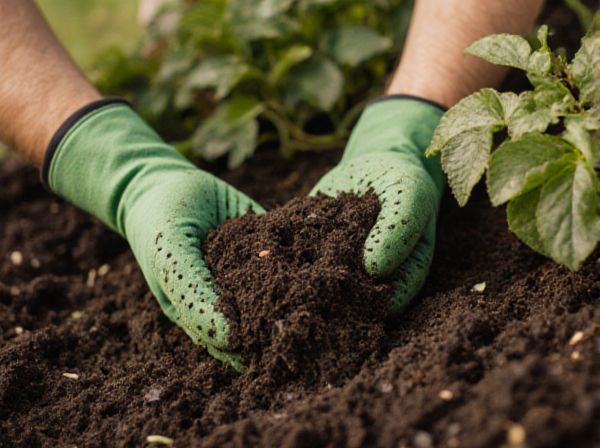
Living Mulch vs Dead Mulch Illustration
Living mulch consists of actively growing plants that cover the soil, enhancing biodiversity and improving soil health by fixing nitrogen and preventing erosion. Dead mulch, made from organic materials like straw or wood chips, conserves moisture, suppresses weeds, and gradually enriches the soil as it decomposes. Choosing between living and dead mulch depends on specific gardening goals, soil conditions, and the desired balance between soil fertility and weed control.
Table of Comparison
| Feature | Living Mulch | Dead Mulch |
|---|---|---|
| Definition | Cover crops or plants grown to protect soil | Organic or inorganic material spread over soil surface |
| Soil Health | Improves soil fertility and structure | Reduces erosion and retains moisture |
| Decomposition | Continuous growth and organic input | Breaks down over time, adding nutrients |
| Weed Control | Competes with weeds effectively | Suppresses weed growth physically |
| Water Retention | Moderate water usage by living plants | Excellent moisture conservation |
| Temperature Regulation | Shades soil to reduce heat stress | Insulates soil from temperature extremes |
| Maintenance | Requires regular management and planting | Low maintenance after application |
| Best Use | Improving soil biological activity | Mulching established plants and garden beds |
Introduction to Living Mulch and Dead Mulch
Living mulch consists of actively growing plants that cover the soil, enhancing soil health by fixing nitrogen, reducing erosion, and supporting beneficial insects. Dead mulch refers to organic materials like straw, leaves, or wood chips spread over the soil surface to conserve moisture, suppress weeds, and improve soil structure as they decompose. Both types of mulch play crucial roles in sustainable agriculture, with living mulch providing dynamic soil benefits and dead mulch offering passive protective functions.
Defining Living Mulch: Pros and Cons
Living mulch, composed of actively growing plants such as clover or vetch, improves soil fertility through nitrogen fixation and enhances biodiversity by attracting beneficial insects. It effectively suppresses weeds and reduces soil erosion but may compete with main crops for water, nutrients, and sunlight, potentially impacting yields. Managing living mulch requires careful selection and timing to balance its benefits against resource competition challenges.
Understanding Dead Mulch: Benefits and Drawbacks
Dead mulch, composed of organic materials like straw, wood chips, or leaves, enhances soil moisture retention and suppresses weed growth by forming a protective layer on the soil surface. This type of mulch improves soil fertility through gradual decomposition, enriching the soil with essential nutrients but may also attract pests or harbor diseases if not managed properly. While dead mulch requires periodic replenishment to maintain effectiveness, its ability to regulate soil temperature and prevent erosion makes it a valuable component in sustainable gardening and agriculture.
Key Differences Between Living and Dead Mulch
Living mulch consists of actively growing plants that provide ground cover, improve soil health through nitrogen fixation, and enhance biodiversity, whereas dead mulch comprises organic or inorganic materials like straw, wood chips, or gravel that suppress weeds and conserve soil moisture without ongoing biological activity. Living mulch requires more management due to potential competition with main crops for nutrients and water, while dead mulch offers a more passive, low-maintenance barrier against erosion and temperature fluctuations. Selection between living and dead mulch depends on specific agricultural goals, such as soil fertility improvement or weed suppression efficiency.
Soil Health Impacts: Living Mulch vs Dead Mulch
Living mulch enhances soil health by increasing organic matter, promoting microbial diversity, and improving soil structure through root activity and nitrogen fixation. Dead mulch, while preventing erosion and conserving moisture, offers slower nutrient cycling and less stimulation of soil biological processes. The choice between living and dead mulch significantly influences soil fertility, moisture retention, and long-term ecosystem resilience.
Weed Suppression Effectiveness: A Comparative Analysis
Living mulch provides superior weed suppression by actively competing with weeds for nutrients, sunlight, and space through continuous growth and canopy cover. Dead mulch suppresses weeds by creating a physical barrier that limits light penetration, but its effectiveness diminishes over time as it decomposes and requires reapplication. Studies indicate that integrated use of living and dead mulches can enhance long-term weed management by combining the dynamic competition of living plants with the structural barrier of organic residue.
Moisture Retention: Which Mulch Performs Better?
Living mulch generally outperforms dead mulch in moisture retention due to its active root systems that improve soil structure and enhance water infiltration. Dead mulch, such as straw or wood chips, provides a protective barrier that reduces evaporation but lacks the biological activity to maintain consistent moisture levels. Studies indicate that living mulch can increase soil moisture content by up to 30% compared to dead mulch under similar environmental conditions.
Maintenance Requirements for Living and Dead Mulch
Living mulch requires regular maintenance including mowing, watering, and occasionally thinning to prevent competition with main crops for nutrients and sunlight. Dead mulch demands less frequent attention but needs periodic replenishing to maintain its insulating and moisture-retaining properties. Both types of mulch contribute to weed suppression but differ significantly in ongoing labor and resource input.
Best Uses and Ideal Plants for Each Mulch Type
Living mulch consists of cover crops such as clover or creeping thyme that enhance soil fertility and prevent erosion, making them ideal for vegetable gardens and orchards where nutrient cycling is crucial. Dead mulch, including straw, wood chips, or shredded leaves, excels at moisture retention and weed control, suited for flower beds, perennial gardens, and around shrubs or trees. Choosing between living and dead mulch depends on specific garden goals, soil conditions, and plant types, with living mulch favored for active soil improvement and dead mulch preferred for passive protection.
Choosing the Right Mulch for Your Garden
Living mulch, composed of low-growing cover crops such as clover or creeping thyme, enhances soil health by fixing nitrogen and preventing erosion while providing habitat for beneficial insects. In contrast, dead mulch materials like wood chips, straw, or composted leaves conserve moisture, regulate soil temperature, and suppress weeds without competing for nutrients. Selecting the right mulch depends on your garden's specific needs, including moisture retention, nutrient cycling, and pest management goals.
Living Mulch vs Dead Mulch Infographic

 gardendif.com
gardendif.com